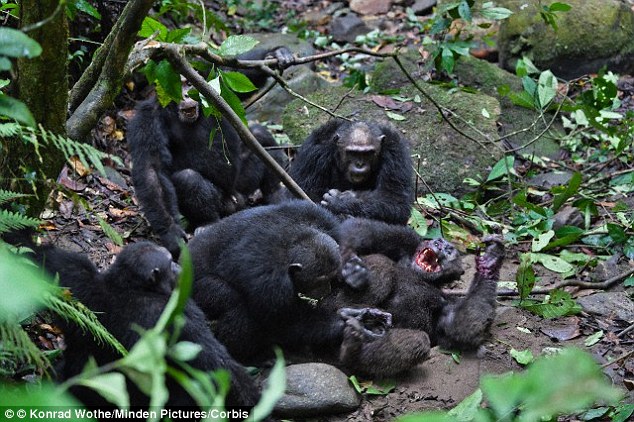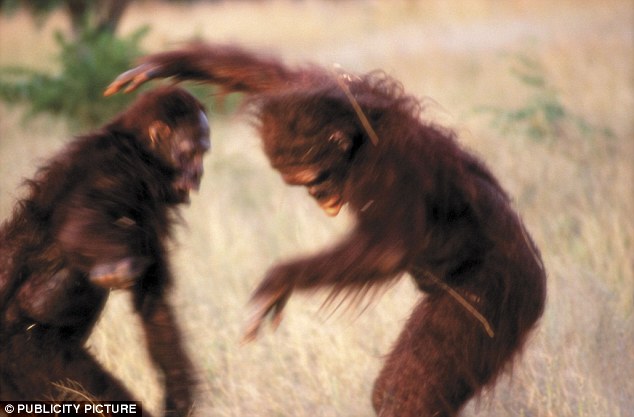The struggle to gain an edge over the enemy in battle has helped to drive some of the greatest technological achievements of the past century, but warfare may also have been responsible for the evolution of human intelligence in the first place, according to new research.
Biologists studying the development of the human brain and our tendency for cooperation believe conflicts played a key role in the way our species developed.
They say that the need to fight, and potentially die, for the benefit of the wide group in wars with neighbouring groups, led our ape-like ancestors to begin working together and helped to drive increasing intelligence.
Growing such large and complex brains places a huge strain on the body’s energy reserves and requires long periods of parental care as the brain develops.
The human brain accounts for just two per cent of the body but uses 20 per cent of the energy.
Yet, despite this, humans have evolved one of the most complex brains in the animal kingdom and have honed an intellect that exceeds all other species.
One explanation given for this is the need to have a large brain in order to cope with social bbehaviour that requires cooperation.
This innate preference to cooperate in a group brings its own costs for humans, argues Dr Sergey Gavrilets, an evolutionary biologist from the University of Tennessee, as some individuals will attempt to get a ‘free-ride’ to the detriment of the wider group.
Dr Gavrilets believes, however, that the pressure of competition and conflicts between neighbouring groups of early humans may have overcome these costs and led to the development of human intelligence.
VIOLENCE AMONG CHIMPANZEES
Violence in ape societies is common between individuals but less common between groups.
However, researchers have begun to uncover evidence of war-like conflict between groups of chimpanzees and bonobos, our closest ape cousins.
Recent results from 50 years of research in 18 chimp and bonobo societies showed that a majority of violent attackers and victims of attack are male chimpanzees.
Primatologists and anthropologists have debated the concept of warfare with some saying increased gains and benefits of killing off competitors opens up access to key resources such as food or mates.
In contrast, others have argued warfare is a result of human impact on chimpanzees – such as habitat destruction or food provisioning – rather than adaptive strategies.
However, in the research with chimps and bonobos, the killing rates did not change with human contact, suggesting the violent clashes were an inherent part of these apes society.
The results are considered to be consistent with the theory that these acts of violence are driven by adaptive fitness benefits rather than human impacts.
He said: ‘There are two general types of collective actions in which our ancestors were almost certainly engaged.
‘The first includes group activities such as defence from predators, some types of hunting or food collection, use of fire.
‘The success of a particular group in these activities – ‘us versus nature’ games – largely does not depend on the actions of neighbouring groups.
‘The second – ‘us versus them’ games – includes conflicts and/or competition with other groups over territory and other resources including mating.
‘The success of a particular group in an ‘us versus them’ game definitely depends on the actions of other neighbouring groups.’
Dr Gavrilets and his colleagues, whose research is published in Journal of the Royal Society Interface, developed a mathematical model to assess how brains may evolve under these scenarios.
Their results show that unless individuals in a group collaborate by performing actions that might be costly to them but beneficial to the group as a whole, then highly collaborative societies cannot evolve.
So groups were individuals were willing to sacrifice themselves to fight for the good of the rest of the group tended to flourish.
Indeed, according to the model, collaborative behaviour evolves most easily if there was direct conflict or warfare between groups.
The findings will also help to explain recent studies that have shown chimpanzees wage wars with competing groups in a similar way to their human cousins. Some groups have also been filmed launching vicious attacks on rivals.
The study also challenges theories on when humans began hunting large game and forging alliances within groups.
Some scientist say that these came first and created the conditions that lead our ancestors to collaborate together to wage war on neighbouring tribes.
However, Gavrilets’ findings suggest that warfare itself could have come first and then led to humans hunting as teams and working together in other tasks.
‘Our ability to effectively collaborate with others is largely responsible for what our species came to be,’ he said.
‘Starting with Darwin’s The descent of man, many researchers view between-group conflict and warfare as a potentially important selective factor in shaping many human characteristics
‘I have provided strong theoretical support to these arguments by showing that between-group conflict can select for increased intelligence and cognitive abilities used to coordinate group activities, potentially overcoming both the high costs of large brains and the collective action problem.’


